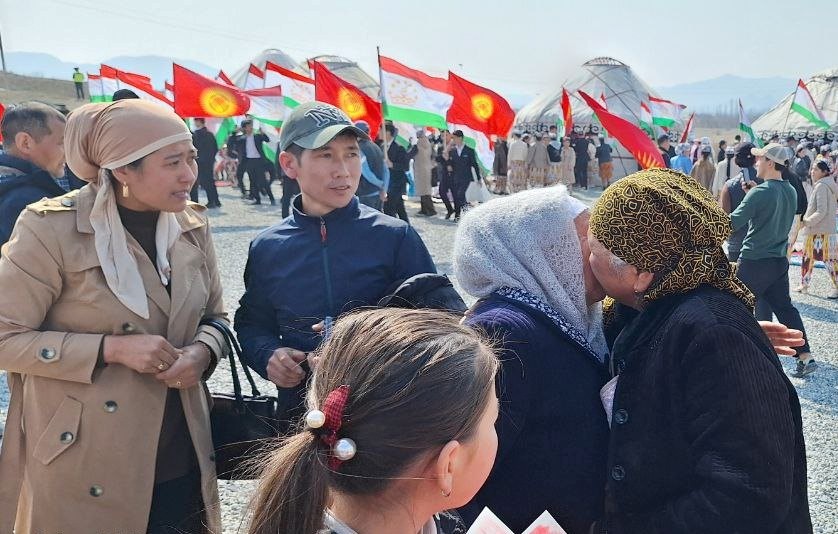Peace between Dushanbe and Bishkek and its advantages
With the border agreement, after four years of deadlock, air links have been re-established and trade routes re-opened. The agreement could usher in a period of strong economic growth, especially for Tajikistan, the most underdeveloped country in all of Central Asia.
Dušanbe (AsiaNews) - The recent border demarcation agreement between Kyrgyzstan and Tajikistan, signed on 13 March after years of tensions and clashes, is one of the few examples of conflict resolution between neighbours in this particularly troubled period, as Pope Francis also pointed out in the Angelus on Sunday 30 March. Experts from Asia-Plus emphasise that this agreement could open a period of great economic growth, especially for Tajikistan, the most underdeveloped country in all of Central Asia.
The text of the agreement, ratified by the respective parliaments on 18 and 19 March, lists 15 points regarding the collaboration between the two countries. An intergovernmental council will be formed, with the main aim of increasing the common trade balance to at least half a billion dollars. As a demonstration of this, the two presidents, Sadyr Žaparov and Emomali Rakhmon, have inaugurated two large shopping centres on both sides of the border areas, Guliston-Kyzyl Bel and Madanijat-Kajragač, connected by new bus lines.
On 14th March the private Tajik company Somon Air made the first flight in four years from Dushanbe to Bishkek, which became a regular service on 23rd March. On 16th March the Kyrgyz company Asman Airlines also opened the air route from Bishkek to Khudzhand, which will become a regular service from 8th April. The parties have also agreed to verify the connection line between the Sogd-500 and Datka stations, as part of the Casa-1000 project.
Trade between the two countries, after the closure of the borders in April 2021, had collapsed by 3.3 times, from almost 40 million dollars in 2020 to 12 million in 2024. Trade was carried out in very small flows through third countries, mainly Uzbekistan, and 93% of it consisted of the delivery of Kyrgyz items to Tajikistan. In general, the percentage of trade with Bishkek for the Dušanbe balance sheet had been reduced to 0.1% in the last 9 months, and the opening of the borders could bring it back up to at least the 2020 level.
Experts believe that the goal of reaching 500 million dollars is not realistic in either the short or medium term, even if the potential for market expansion should not be underestimated. In fact, both countries lack oil and energy resources, which condemns them to remain in a marginal position compared to their neighbours Kazakhstan, Uzbekistan and even Turkmenistan. The Kyrgyz and Tajik economies develop in parallel only in the export of generic and ‘non-critical’ raw materials, importing foreign-made items.
Kyrgyzstan mainly exports coal and refined Russian oil, as well as some Kazakh and Chinese products, which were bought by Tajik traders in the famous Dordoj market in Bishkek. Tajikistan mainly exports agricultural products, such as fruit and vegetables, as well as some building materials. Those who suffered most from the closing of the borders were the inhabitants of the frontier areas, who depended on commercial exchanges linked by centuries-old traditions to the frontier markets, where one could buy and sell anything. Since ancient times it had been customary to meet on Tuesdays in the Kyrgyz village of Arka in the Batken region, and on Sundays in the Tajik village of Khistevarz Sogda.
In addition to products and market goods, both countries also suffered a sharp decline in the supply of services, especially considering that the conflict broke out in the middle of the Covid-19 pandemic. Land and air transport, telephone connections, hotel services and power lines have remained at medium to low levels, and now great growth is expected in these sectors. The Tajiks will have the opportunity to supply cheap Chinese-made goods through the northern routes of the country, and Kyrgyzstan has committed to act as a mediator to export Tajik production to the Eurasian Economic Union market. Significant investments will be needed in the sectors of mutual interest for development, and this will involve the further involvement of the major international partners, Russia and especially China, but also the European Union.
12/02/2016 15:14







.png)










